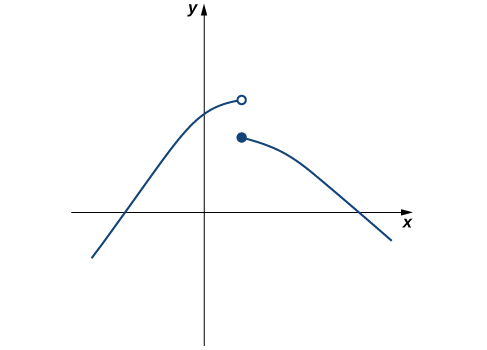- Define the limit of a function using proper notation and estimate limits from tables and graphs
- Define one-sided limits with examples and explain their relationship to two-sided limits.
- Describe infinite limits using correct notation and define vertical asymptotes
The Definition of a Limit
The Main Idea
- Intuitive Definition of a Limit:
- As [latex]x[/latex] approaches [latex]a[/latex], [latex]f(x)[/latex] gets arbitrarily close to [latex]L[/latex]
- Notation: [latex]\lim_{x \to a} f(x) = L[/latex]
- Estimating Limits: a. Using Tables:
- Create tables approaching the point from both sides
- Observe if values converge to a single number b. Using Graphs:
- Examine function behavior near the point of interest
- Look for y-value that the function approaches
- Basic Limit Properties:
- [latex]\lim_{x \to a} x = a[/latex]
- [latex]\lim_{x \to a} c = c[/latex] (c is a constant)
- Existence of Limits:
- A limit exists if function values converge to a single, real number
- Limits may not exist due to oscillation or divergence
Evaluate [latex]\underset{x\to 0}{\lim}\dfrac{\sin x}{x}[/latex] using a table of functional values.
Estimate [latex]\underset{x\to 1}{\lim}\dfrac{\frac{1}{x}-1}{x-1}[/latex] using a table of functional values. Use a graph to confirm your estimate.
Use the graph of [latex]h(x)[/latex] in the figure below to evaluate [latex]\underset{x\to 2}{\lim}h(x)[/latex], if possible.
![A graph of the function h(x), which is a parabola graphed over [-2.5, 5]. There is an open circle where the vertex should be at the point (2,-1).](https://s3-us-west-2.amazonaws.com/courses-images/wp-content/uploads/sites/2332/2018/01/11202902/CNX_Calc_Figure_02_02_007.jpg)
Use a table of functional values to evaluate [latex]\underset{x\to 2}{\lim}\dfrac{|x^2-4|}{x-2}[/latex], if possible.
One-Sided and Two-Sided Limits
The Main Idea
- One-Sided Limits:
- Left-hand limit: [latex]\lim_{x \to a^-} f(x) = L[/latex]
- Right-hand limit: [latex]\lim_{x \to a^+} f(x) = L[/latex]
- Two-Sided Limits:
- Exist only if both one-sided limits exist and are equal
- [latex]\lim_{x \to a} f(x) = L[/latex] if and only if [latex]\lim_{x \to a^-} f(x) = \lim_{x \to a^+} f(x) = L[/latex]
- Relationship between One-Sided and Two-Sided Limits:
- Two-sided limit exists if and only if both one-sided limits exist and are equal
- If one-sided limits differ, the two-sided limit does not exist
- Evaluating One-Sided Limits:
- Use tables of values approaching from left or right
- Examine graphs for behavior as [latex]x[/latex] approaches [latex]a[/latex] from each side
Use a table of functional values to estimate the following limits, if possible.
- [latex]\underset{x\to 2^-}{\lim}\dfrac{|x^2-4|}{x-2}[/latex]
- [latex]\underset{x\to 2^+}{\lim}\dfrac{|x^2-4|}{x-2}[/latex]
Evaluate the one-sided and two-sided limits (if they exist) for the following piecewise function:
[latex]f(x) = \begin{cases} x^2 + 1, & \text{if } x < 2 \ 3x - 5, & \text{if } x \geq 2 \end{cases}[/latex]
as [latex]x[/latex] approaches [latex]2[/latex].
Infinite Limits
The Main Idea
- Infinite Limits:
- Occur when function values grow without bound
- Notation: [latex]\lim_{x \to a} f(x) = \pm\infty[/latex]
- Infinite limits often indicate discontinuities in functions
- One-Sided Infinite Limits:
- Left-hand: [latex]\lim_{x \to a^-} f(x) = \pm\infty[/latex]
- Right-hand: [latex]\lim_{x \to a^+} f(x) = \pm\infty[/latex]
- Vertical Asymptotes:
- Occur where function approaches infinity as x approaches a value
- Line [latex]x = a[/latex] is a vertical asymptote if any of: [latex]\lim_{x \to a^-} f(x) = \pm\infty[/latex] [latex]\lim_{x \to a^+} f(x) = \pm\infty[/latex] [latex]\lim_{x \to a} f(x) = \pm\infty[/latex]
- Behavior of [latex]\frac{1}{(x-a)^n}[/latex]:
- Even [latex]n[/latex]: [latex]\lim_{x \to a} \frac{1}{(x-a)^n} = +\infty[/latex]
- Odd [latex]n[/latex]: [latex]\lim_{x \to a^+} \frac{1}{(x-a)^n} = +\infty[/latex] and [latex]\lim_{x \to a^-} \frac{1}{(x-a)^n} = -\infty[/latex]
Evaluate each of the following limits, if possible. Use a table of functional values and graph [latex]f(x)=\dfrac{1}{x^2}[/latex] to confirm your conclusion.
- [latex]\underset{x\to 0^-}{\lim}\frac{1}{x^2}[/latex]
- [latex]\underset{x\to 0^+}{\lim}\frac{1}{x^2}[/latex]
- [latex]\underset{x\to 0}{\lim}\frac{1}{x^2}[/latex]
Evaluate each of the following limits. Identify any vertical asymptotes of the function [latex]f(x)=\dfrac{1}{(x-2)^3}[/latex].
- [latex]\underset{x\to 2^-}{\lim}\dfrac{1}{(x-2)^3}[/latex]
- [latex]\underset{x\to 2^+}{\lim}\dfrac{1}{(x-2)^3}[/latex]
- [latex]\underset{x\to 2}{\lim}\dfrac{1}{(x-2)^3}[/latex]
Evaluate [latex]\underset{x\to 1}{\lim}f(x)[/latex] for [latex]f(x)[/latex] shown here:

![A graph of f(x) = sin(x)/x over the interval [-6, 6]. The curving function has a y intercept at x=0 and x intercepts at y=pi and y=-pi.](https://s3-us-west-2.amazonaws.com/courses-images/wp-content/uploads/sites/2332/2018/01/11202852/CNX_Calc_Figure_02_02_003.jpg)